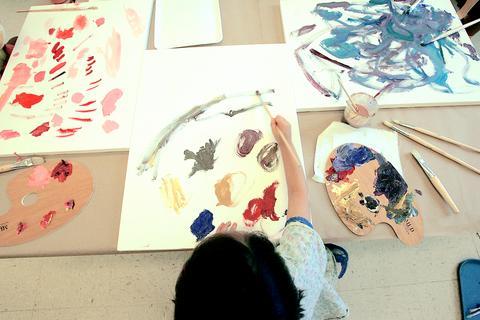Is every 4-year-old a Marla Olmstead?
Marla is the preschool painter from Binghamton, New York, who has had her own gallery show. The gallery owner who represents her -- because what 4-year-old doesn't need gallery representation? -- is charging US$6,000 for her latest works. Never mind whether she is a larger-than-life talent: Every canvas she splatters and scrapes her way across is larger than she is.

PHOTO: NY TIMES
No doubt some parents who heard about her accomplishments said to themselves, "My 4-year-old could do that."
In an experiment that touched on how creativity emerges, how it is nurtured and how the skills needed for painting differ from those needed for, say, piano playing, a group of 4-year-olds was asked to try its hand at oil on canvas. Later, the children's paintings were shown to an adult with credentials in early education and long experience in children's art, Andrew S. Ackerman, the executive director of the Children's Museum of Manhattan.
Painting with oil on canvas was something of a stretch for artists accustomed to tempera and construction paper. But their art teacher at the Weekday School at the Riverside Church in Manhattan, Naomi Hudson-Knapp -- "Miss Naomi" to the children -- was ready to start them off as soon as they slithered into their smocks.
She began by explaining that oil paint is "smooth and silky" and different from anything they had used before. Not only that, but the canvas they would paint on had a texture different from paper, a bit bumpy and a bit resistant, even to a brush loaded with paint.
She also explained that the wooden board with little dabs of paint was called a palette.
Finally she told the children they could choose their brushes: wide, narrow or in-between.
The 4-year-olds went to work in a noisy blur of creativity. In less time than it takes Big Bird to run through the alphabet, Isabelle Harris, a little girl in a yellow smock, announced, "I made a Jackson Pollock."
A Jackson Pollock?
"It's the one that was at the Metropolitan Museum," she said.
Across the room her mother, Cydney Harris, knew exactly what Isabelle was talking about: Pollock's Autumn Rhythm, which is considered an incomparable example of Abstract Expressionism, and is also one of the largest and most important examples of his poured technique. Preschoolers know the painting from Olivia, the picture book by Ian Falconer about a precocious pig who sees it at the Met and then goes home and imitates it.
Isabelle -- "she loves art but is not very good," Harris said -- had seen Autumn Rhythm in a book at home and declared, "That scares me." This was before Harris talked her into going to the Met one day after a visit to the doctor.
Isabelle recognized Autumn Rhythm from a distance and trotted toward it, raising her arms as if to embrace it. "She said: `It doesn't scare me. It's beautiful. Look at all the colors,'" Harris said. "We stood there for 30 minutes and had a huge discussion about which way to hang it."
The question remained, could she be the next prodigy with a paintbrush? What about her classmate Matthew Popkin, who explained that his painting depicted "some sort of criminal" that skulks around at night? What about Alice Wright, who had worked at the one easel in the classroom (the other children had sat around a large table)? Before she wiggled out of her purple smock, Alice said her canvas of wide and mostly vertical reddish-orange brush strokes, which trailed off in drippy, runny pastels near the bottom, "doesn't really show anything" and was "just a bunch of paint."
Later, when high-resolution images of six of the children's paintings were sent by e-mail to Ackerman of the Children's Museum, he said Alice's painting was the one that he would show to other adults to see what they thought the painter was trying to depict.
"The difference is, a painter is trying to depict something," he said. "A child is just exploring."
He added: "Sometimes, when a child creates something, if it happens to hit the sweet spot of what we think modern art or abstract art is, then the adult steps back and says, `Wow, look at what the child has created,' when in fact, the child who's created something that looks sophisticated to us may just be doing the same thing as every other 4-year-old."
The experiment -- having 4-year-olds paint, and then having Ackerman review the results -- touched on more than innate talent, he said. "What's interesting about young children and art is they not only have to have the eye of a visual thinker, but the manual dexterity," he said.
Marla Olmstead, the 4-year-old with the gallery show, long ago passed the stage of experimentation. But, as with Matthew's criminal, what an artist of 4 says a painting represents may be an afterthought, some child development specialists say.
"The value of actually being a child is you are for the most part residing in a world where you are not aware of what you can't be doing just yet, so children, by their nature, are unguarded, uncensored," said Dr. Regina Lara, medical director of the child psychiatric outpatient department at the Mount Sinai Medical Center.
So, will Marla still be painting at, say, 6? Or will she outgrow her career?
"If painting is a huge part of her world, she may continue to embrace it or she may let go of it," said Hudson-Knapp, the art teacher. "If you're familiar with the vocabulary from the time you're 1, by the time you're 4, you're familiar with the medium. You're comfortable with it, so when you have an idea you want to express, you know how to do it."

When Taiwan was battered by storms this summer, the only crumb of comfort I could take was knowing that some advice I’d drafted several weeks earlier had been correct. Regarding the Southern Cross-Island Highway (南橫公路), a spectacular high-elevation route connecting Taiwan’s southwest with the country’s southeast, I’d written: “The precarious existence of this road cannot be overstated; those hoping to drive or ride all the way across should have a backup plan.” As this article was going to press, the middle section of the highway, between Meishankou (梅山口) in Kaohsiung and Siangyang (向陽) in Taitung County, was still closed to outsiders

President William Lai (賴清德) has championed Taiwan as an “AI Island” — an artificial intelligence (AI) hub powering the global tech economy. But without major shifts in talent, funding and strategic direction, this vision risks becoming a static fortress: indispensable, yet immobile and vulnerable. It’s time to reframe Taiwan’s ambition. Time to move from a resource-rich AI island to an AI Armada. Why change metaphors? Because choosing the right metaphor shapes both understanding and strategy. The “AI Island” frames our national ambition as a static fortress that, while valuable, is still vulnerable and reactive. Shifting our metaphor to an “AI Armada”

US President Donald Trump may have hoped for an impromptu talk with his old friend Kim Jong-un during a recent trip to Asia, but analysts say the increasingly emboldened North Korean despot had few good reasons to join the photo-op. Trump sent repeated overtures to Kim during his barnstorming tour of Asia, saying he was “100 percent” open to a meeting and even bucking decades of US policy by conceding that North Korea was “sort of a nuclear power.” But Pyongyang kept mum on the invitation, instead firing off missiles and sending its foreign minister to Russia and Belarus, with whom it

The Chinese Communist Party (CCP) has a dystopian, radical and dangerous conception of itself. Few are aware of this very fundamental difference between how they view power and how the rest of the world does. Even those of us who have lived in China sometimes fall back into the trap of viewing it through the lens of the power relationships common throughout the rest of the world, instead of understanding the CCP as it conceives of itself. Broadly speaking, the concepts of the people, race, culture, civilization, nation, government and religion are separate, though often overlapping and intertwined. A government